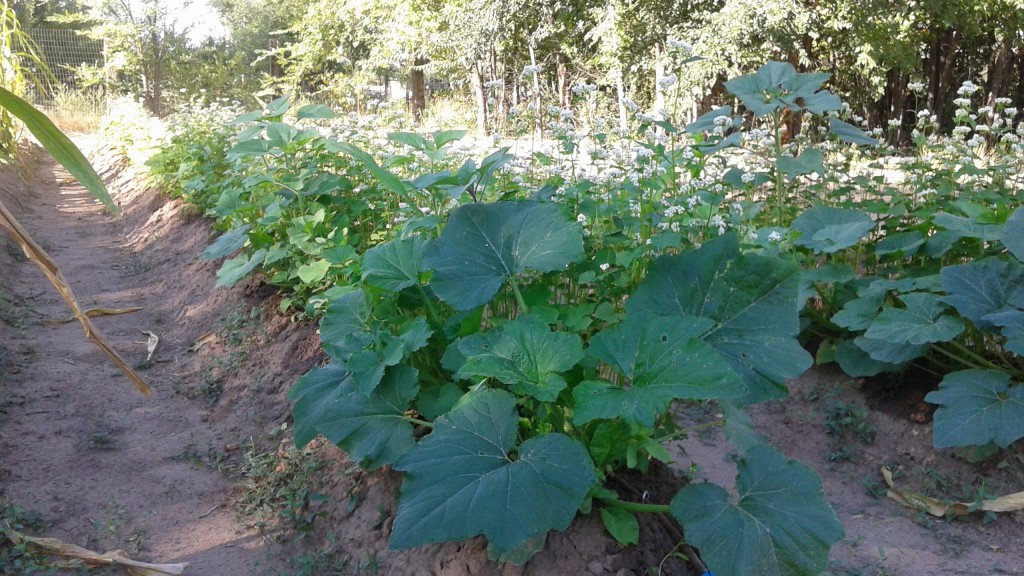The folks over at Cafe Bella Coffee in Rio Rancho New Mexico decided to experiment with the tomatoes that I had delivered for the salsa they prepare for Taco Tuesday, and crafted the “Arenoso Tomato Sandwich”. The Cherokee Purple tomato has a distinct taste and I feel that it’s really good in a salsa, but by itself can hold down the fort also, and compliments a sandwich with a rich tomato flavor that a regular conventionally farmed tomato cannot do, as they usual must travel hundreds if not thousands of miles to the restaurant, or are picked weeks prior – our tomatoes are picked and delivered within an hour and we are only 6 miles from this restaurant(super fresh). Cafe Bella Coffee embraces the “farm to table” movement, and we are super excited to know that a sandwich was designed to capture the flavor that these tomatoes have, and we wanted to say thank you.
Month: September 2015
Observation: Many species with buckwheat
On the west side of the field, there seems to be a buildup of sandy soil, unlike the center of the field, or the east side of the field. It has taken much thinking, but I feel that the reason there is such a concentration of fine sandy soil on this west side of the field, was caused by wind and to some extent, water erosion. For the majority of this fields working life, people that used “east-to-west”(easier to work) rows to grow the cash crop – I decided at the start of the season, that I would change this and use a “north-to-south” row setup, in the hope that wind eroded soil would end up hitting the next row of crops and fall to the ground, and not continue to move or become a particle in the air. At the start of the spring, I realized that this part of the field needed help, and I would test one crop to find out if this row is actually “dead soil(no organic material)” – green beans were planted, and out of the 40 something seeds I planted, 13 grew, and 8 plants made the entire season – even with irrigation, and compost that was added to this row, this “easily” grown plant, wasn’t happy. At the start of August, I decided to plant a variety of crops in the other two rows that I left fallow during the summer, along with a cover crop called buckwheat; the buckwheat was partially intended to help feed the honey bee’s that are living on this parcel(they LOVE it), but also to be be beneficial to the soil by creating organic material in the soil with their root system and being able to extract insoluble phosphorus from the soil, and allowing the plants near them to benefit from the bringing up this phosphorus.
I honestly did not expect to see these plants growing happily next to the buckwheat crop – the leaves on this squash plant are the largest I have personally grown in the last 3 years, the sunflower stock seems larger than the others I have grown, and I really feel that the reason they are so happy is: diversity.
Diverse cover crops
Cover crops are essential to building healthy soil, and the more types that are grown, the better. A bit less than a month ago, I decided to plant some buckwheat in the rows on the west side of the field that were fallow this warm season. Now that the flowers have emerged from the buckwheat, the honey bee’s have been foraging from them in the morning, with literally hundreds seen in the two rows of buckwheat. Although I planted the buckwheat to help feed the bee’s this season, I also planted buckwheat to reap the benefits of it, which are the ability to extract phosphorus from the soil, branching root system, weed suppressant, and for organic matter that they will become when they are finished growing this winter. I started with 5 different species this fall, those being hairy vetch, oats, peas, buckwheat and yellow clover. After doing more research and watching some videos from Gabe Brown of Browns Ranch in Bismark ND, I realized that I needed to add at minimal, a couple of more types of plants to the cover crop that I was planning to grow this year. I added rye and white clover to the mix today, and will look for a radish or turnip to plant along with the other 7 species. All these species have their benefits, from breaking up hard compacted soil, covering the soil to stop wind and water erosion, to adding nitrogen and other nutrients, and adding organic material to the soil – all of these are required to build a healthy soil, which will create healthy and happy plants.


